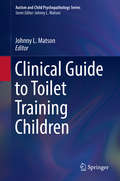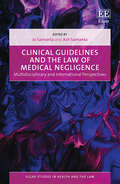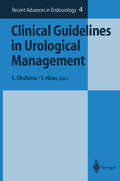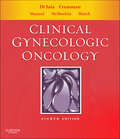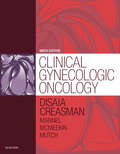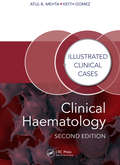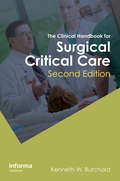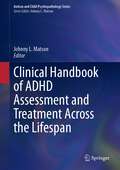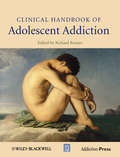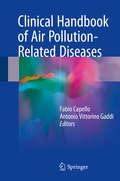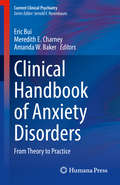- Table View
- List View
A Clinical Guide to the Treatment of the Human Stress Response
by George S. Everly, Jr. Jeffrey M. LatingThis new edition emphasizes the unique contribution of this longstanding text in the integration of mind/body relationships. The concept of stress, as defined and elaborated in Chapter 1, the primary efferent biological mechanisms of the human stress response, as described in Chapter 2, and the link from stress arousal to disease, as defined in Chapter 3, essentially remains the same. However, updates in microanatomy, biochemistry and tomography are added to these chapters. All other chapters will be updated as well, as there has been significant changes in the field over the past eight years.
A Clinical Guide to the Treatment of the Human Stress Response (Springer Series On Stress And Coping Ser.)
by Jeffrey M. Lating George S. Everly, Jr.This comprehensive update of the now classic text applies the most current findings across disciplines to the treatment of pathogenic human stress arousal. New and revised chapters bring together the art and science of intervention, based in up-to-date neuroscience, starting with an innovative model tracing the stress-to-disease continuum throughout the systems of the human body. The authors detail the spectrum of physiological and psychological treatments for the stress response, including cognitive therapy, neuromuscular relaxation, breathing exercises, nutritional interventions, and pharmacotherapy. They also assess the strengths and limitations of widely-used measures of the stress response and consider the value of personality factors, cultural considerations, and resilience in stress mediation.Included in the coverage:The anatomy and physiology of the human stress response.Advances in neuroscience: implications for stress.Crisis intervention and psychological first aid.Neurophysiological rationale for the use of the relaxation response.Physical exercise and the human stress response. The pharmacological management of stress reactions. Disaster Mental Health Planning.Cultural Awareness and Stress.The Fourth Edition of A Clinical Guide to the Treatment of Human Stress Response offers readers a dual perspective, exceedingly useful in examining the origins of the stress response, and in preventing and treating the response itself. This rich integrative volume will join its predecessors in popularity among practitioners and students across disciplines and specialties.
Clinical Guide to the Use of Antithrombotic Drugs in Coronary Artery Disease
by Adnan Kastrati Daniel Simon Dominick AngiolilloAppreciation of the importance of platelets and coagulation factors in therothrombotic events has led to the widespread use and continuous development of new antithrombotic agents. This field of cardiovascular pharmacology has advanced at a very rapid rate. Understanding the basic principles of atherothrombosis as well as the pharmacological agents
Clinical Guide to Toilet Training Children (Autism and Child Psychopathology Series)
by Johnny L. MatsonThis book offers a comprehensive overview of the universal issue of toilet training in children and explores issues that need to be considered by clinicians and other professionals. The book begins with a historical overview of the field, including origins and reviews of current practices. It discusses various toileting problems and their side effects, risk factors, normal developmental milestones in toileting, and theories of toileting. Chapters identify behavior problems (e.g., self-injury, noncompliance) as well as medical conditions (e.g., diabetes, constipation) that can affect continence, with proven strategies for addressing these challenges in toilet training children, including those with intellectual and developmental disabilities. The book concludes with a discussion of the strengths of current toilet training practices as well as suggestions for areas where continued improvement is required.Topics featured in this book include:· Complications and side effects associated with the lack of toileting skills.· Technology used in toilet training.· Applications of operant-based behavioral principles to toilet training.· Toilet training strategies involving modeling and modifications of the physical environment.· Toilet training children with physical disabilities. The Clinical Guide to Toilet Training Children is a must-have resource for researchers, graduate students, clinicians, and related therapists and professionals in clinical child and school psychology, pediatrics, family studies, developmental psychology, nursing, social work, and behavioral therapy/rehabilitation.
A Clinical Guide to Transcranial Magnetic Stimulation
by Paul E. Holtzheimer William McDonaldThe Clinical Guide serves as a reference tool for clinicians in the administration of transcranial magnetic stimulation (TMS) for neuropsychiatric disorders. The primary intent of this Guide is to focus on the clinical applications of TMS and to offer detailed information on the safe and effective administration of TMS with consideration of the neurophysiological effects particularly in relation to safety, targeting specific cortical areas and practical issues such as the length of treatment sessions and the durability of the TMS response. The Guide focuses on the evidenced based literature and utilizes this literature to inform specific recommendations on the use of rTMS in a clinical setting. The efficacy and safety of TMS for neuropsychiatric disorders, including its use in special populations, such as the elderly, will be reviewed to facilitate clinical decision-making. The Guide will also outline setting up a TMS service including practical issues such as considerations for the qualifications of the person administering the treatment, the use of concomitant medications, what equipment is necessary to have in the treatment room and monitoring the outcomes to treatment. The Guide is intended to be a practical reference for the practicing clinician in the safe and effective administration of TMS.
A Clinical Guide to Transcranial Magnetic Stimulation
by Paul E. Holtzheimer; William McDonaldThe Clinical Guide serves as a reference tool for clinicians in the administration of transcranial magnetic stimulation (TMS) for neuropsychiatric disorders. The primary intent of this Guide is to focus on the clinical applications of TMS and to offer detailed information on the safe and effective administration of TMS with consideration of the neurophysiological effects particularly in relation to safety, targeting specific cortical areas and practical issues such as the length of treatment sessions and the durability of the TMS response. The Guide focuses on the evidenced based literature and utilizes this literature to inform specific recommendations on the use of rTMS in a clinical setting. The efficacy and safety of TMS for neuropsychiatric disorders, including its use in special populations, such as the elderly, will be reviewed to facilitate clinical decision-making. The Guide will also outline setting up a TMS service including practical issues such as considerations for the qualifications of the person administering the treatment, the use of concomitant medications, what equipment is necessary to have in the treatment room and monitoring the outcomes to treatment. The Guide is intended to be a practical reference for the practicing clinician in the safe and effective administration of TMS.
Clinical Guide to Transplantation in Lymphoma
by Bipin N. Savani Mohamad MohtyThe first book on clinical guide to transplantation in lymphoma to present cutting edge knowledge on how to integrate, transplantation and novel therapies in patients with lymphoid malignancies Provides practical management guidance on how to integrate, transplantation and novel therapies in patients with lymphoid malignancies Covers an overview of transplantation in lymphoma, and management of the lymphoid malignancies Discusses organizational aspects of transplant patients and managing a transplant program Appendices provide practical quick-reference information on follow-up after autologous and allogenic stem cell transplantation in lymphoma
Clinical Guide to Transplantation in Lymphoma
by Bipin N. Savani Mohamad MohtyThe first book on clinical guide to transplantation in lymphoma to present cutting edge knowledge on how to integrate, transplantation and novel therapies in patients with lymphoid malignancies Provides practical management guidance on how to integrate, transplantation and novel therapies in patients with lymphoid malignancies Covers an overview of transplantation in lymphoma, and management of the lymphoid malignancies Discusses organizational aspects of transplant patients and managing a transplant program Appendices provide practical quick-reference information on follow-up after autologous and allogenic stem cell transplantation in lymphoma
A Clinical Guide to Urologic Emergencies
by Hunter Wessells Shigeo Horie Reynaldo G. GómezA Clinical Guide to Urologic Emergencies A Clinical Guide to Urologic EmergenciesAn ageing population and a predicted shortfall in the number of urologists means that, increasingly, the management of complex urological problems will fall to hospital emergency departments and the surgeries of primary care physicians. With many doctors and medical students now having less exposure to urology, there is a real and urgent need for accessible and practical guidance in managing urologic emergencies.A Clinical Guide to Urologic Emergencies offers practical guidance to the best practices in diagnosis, treatment and management of patients with urgent urological conditions. Designed to be an extremely useful tool to consult in the clinical setting, it will be a vital source of information and guidance for all clinicians, irrespective of their level of urologic knowledge.Edited by an outstanding international editor team, this book is particularly aimed at physicians, advanced practice providers, and urology and emergency medicine trainees managing patients in diverse healthcare settings across the globe.A Clinical Guide to Urologic Emergencies is accompanied by a website featuring video content at www.wiley.com/go/wessells/urologic
A Clinical Guide to Urologic Emergencies
A Clinical Guide to Urologic Emergencies A Clinical Guide to Urologic EmergenciesAn ageing population and a predicted shortfall in the number of urologists means that, increasingly, the management of complex urological problems will fall to hospital emergency departments and the surgeries of primary care physicians. With many doctors and medical students now having less exposure to urology, there is a real and urgent need for accessible and practical guidance in managing urologic emergencies.A Clinical Guide to Urologic Emergencies offers practical guidance to the best practices in diagnosis, treatment and management of patients with urgent urological conditions. Designed to be an extremely useful tool to consult in the clinical setting, it will be a vital source of information and guidance for all clinicians, irrespective of their level of urologic knowledge.Edited by an outstanding international editor team, this book is particularly aimed at physicians, advanced practice providers, and urology and emergency medicine trainees managing patients in diverse healthcare settings across the globe.A Clinical Guide to Urologic Emergencies is accompanied by a website featuring video content at www.wiley.com/go/wessells/urologic
Clinical Guidelines and Care Protocols
by Jaqui Hewitt-TaylorThe book begins by placing clinical guidelines within the context of the broader movement towards evidence based practice; it explores the concept of evidence, and defines clinical guidelines and care protocols. These are then examined in the clinical situation. The book goes on to discuss the relationship between them and the exercise of individual autonomy and expertise, and with individualised care and patient involvement and choice. The influence of cost on decision making is reviewed, and a chapter discusses the political aspects of care guidelines and protocols. Finally the book describes the implementation of guidelines and protocols and the barriers to implementation, and makes suggestions for the future.
Clinical Guidelines and the Law: Negligence, Discretion, and Judgement
by Brian HurwitzGuidelines are powerful instruments of assistance to clinicians, capable of extending the clinical roles of nurses and pharmacists. Purchasers and managers perceive them as technological tools guaranteeing treatment quality. Guidelines also offer mechanisms by which doctors and other health care professionals can be made more accountable to their patients. - But how can clinicians tell whether a guideline has authority, and whether or not it should be followed? - Does the law protect doctors who comply with guidelines? - Are guideline developers liable for faulty advice? This timely book provides a comprehensive and accessible analysis of the many medical and legal issues arising from the current explosion of clinical guidelines. Featuring clear summaries of relevant UK, US and Commonwealth case law, it is vital reading for all doctors, health care workers, managers, purchasers, patients, and lawyers.
Clinical Guidelines and the Law: Negligence, Discretion, and Judgement
by Brian HurwitzGuidelines are powerful instruments of assistance to clinicians, capable of extending the clinical roles of nurses and pharmacists. Purchasers and managers perceive them as technological tools guaranteeing treatment quality. Guidelines also offer mechanisms by which doctors and other health care professionals can be made more accountable to their patients. - But how can clinicians tell whether a guideline has authority, and whether or not it should be followed? - Does the law protect doctors who comply with guidelines? - Are guideline developers liable for faulty advice? This timely book provides a comprehensive and accessible analysis of the many medical and legal issues arising from the current explosion of clinical guidelines. Featuring clear summaries of relevant UK, US and Commonwealth case law, it is vital reading for all doctors, health care workers, managers, purchasers, patients, and lawyers.
Clinical Guidelines and the Law of Medical Negligence: Multidisciplinary and International Perspectives (Elgar Studies in Health and the Law)
This book critically considers the dynamic relationship between clinical guidelines and medical negligence litigation, arguing that a balance must be struck between blinkered reliance on guidelines and casual disregard. It explores connections between academic law and professional practice, bringing together an array of perspectives which reveal that although guidelines may not be dispositive, they nonetheless play an important role in medical negligence law.The chapters provide compelling insights from academics, lawyers, barristers, doctors and healthcare professionals into the use of guidelines in determining the legal standard for breach of duty, thereby contributing to a holistic understanding of guideline usage in this area of law. Sociological considerations along with empirical findings are used to underpin these concepts. While focusing on the UK, contributors draw upon international law including that from the United States, South Africa, the Netherlands and other countries. Based on this analysis the conclusion offers a theoretical framework for practical application illustrated by a case-based discourse.This book makes a significant contribution to the knowledge base in the subject area. It is an essential read for legal academics and lawyers working in medical and health law, as well as for doctors and other healthcare professionals. It will be a key reference point for medical regulators, health organisation policymakers and clinical governance teams.
Clinical Guidelines in Urological Management (Recent Advances in Endourology #4)
by YoshihikoHirao ShinichiOhshimaThe twenty-first century will be the era of the market economy, a century char acterized by the penetration of market forces into every social field, even into government activities, education, and medical care. Guidelines for the provision of clinical care have been developed in recent years chiefly in American health-care services, which are the most thoroughly exposed to the market economy. The problem of escalating medical costs in the United States led the government and consumer groups to introduce clinical practice guidelines. Guidelines were introduced to control medical costs and quality. Initially, guidelines were developed mainly on the consumer side, but professionals, too, soon recognized the importance of clinical practice guidelines. The involvement of diverse groups in the development of guidelines has inten sified the need to create and improve scientific methods for drawing up those guidelines. Owing to the development of systematic and structured abstraction methods, evidence-based guidelines have been proposed. Principally, guidelines are a sum mary of published treatments created by statistical analysis of clinical outcomes.
Clinical Gynecologic Oncology E-Book
by Philip J. DiSaia William T. CreasmanClinical Gynecologic Oncology, by Drs. Di Saia and Creasman, is the leading medical reference book geared toward helping you improve gynecologic cancer outcomes. You’ll see how to take advantage of the latest advances in early detection and improved treatment options for gynecologic cancers, especially uterine and cervical cancers, equipping you with the skills you need to provide effective and compassionate care for your patients.Easily identify and absorb key information with outlines beginning each chapter. Choose the best management plan for each patient using algorithms throughout the book. Stay at the forefront of your field thanks to new chapters on Genetic Counseling and Clinical Management of Inherited Disease; Molecular Genetics; and Minimally Invasive Surgery, plus sweeping updates covering all the latest advances. Find everything you need to face your daily challenges with appendices covering staging, screening, nutritional therapy, toxicity criteria, blood component therapy, and radiation therapy. Locate answers fast with a chapter organization based on cancer type and size.
Clinical Gynecologic Oncology E-Book: Expert Consult - Online And Print
by Philip J. DiSaia William T. Creasman Robert S Mannel D. Scott McMeekin David G MutchThe most readable, most comprehensive book in its field, Clinical Gynecologic Oncology, 9th Edition is the leading reference for diagnosis and treatment of gynecologic cancers – a must-have reference for improving outcomes and providing effective care. A "who’s who" list of contributing authors, under the editorial direction of Drs. Philip DiSaia and William Creasman, provides expert guidance on clinical presentations and management, now fully up to date with a brand-new design for faster, easier reference.Contains useful appendices covering staging, screening, nutritional therapy, toxicity criteria, blood component therapy, and radiation therapy.Covers hot topics such as multi-panel genetic testing, target therapies, sentinel node concept in endometrial cancer and vulvar cancer, and robotic surgery. Updates include new quick-reference features such as key point boxes with bulleted lists, highlighted key text, enhanced chapter outlines, and a brand-new design throughout. Includes up-to-date references and algorithms, making this text a comprehensive resource for clinical practice, personal study, and exam review. Helps you take advantage of the latest advances in early detection and improved treatment options for gynecologic cancers, especially uterine and cervical cancers.
Clinical Haematology: Illustrated Clinical Cases (Illustrated Clinical Cases)
by Atul Bhanu Mehta Keith GomezThis fully illustrated text is an essential guide for trainees in Haematology and Medicine studying for higher examinations, as well as for professionals wishing to expand their knowledge or revalidate. The book contains over 100 illustrated cases covering the whole field of malignant and non-malignant haematology, including coagulation problems and infectious diseases. Each case contains a set of questions written by two Royal College examiners, with answers on the reverse page. Readers can make differential diagnoses and devise treatment plans and prognoses, before turning the page to read the experts’ detailed answers. The cases are presented in random order – just as they would be in real life – and are of varying lengths and degrees of difficulty, accompanied by hundreds of colour photomicrographs, photographs, and x-rays. This new edition is revised and updated, with new cases, images, and tables.
Clinical Haematology: Illustrated Clinical Cases (Illustrated Clinical Cases)
by Atul Bhanu Mehta Keith GomezThis fully illustrated text is an essential guide for trainees in Haematology and Medicine studying for higher examinations, as well as for professionals wishing to expand their knowledge or revalidate. The book contains over 100 illustrated cases covering the whole field of malignant and non-malignant haematology, including coagulation problems and infectious diseases. Each case contains a set of questions written by two Royal College examiners, with answers on the reverse page. Readers can make differential diagnoses and devise treatment plans and prognoses, before turning the page to read the experts’ detailed answers. The cases are presented in random order – just as they would be in real life – and are of varying lengths and degrees of difficulty, accompanied by hundreds of colour photomicrographs, photographs, and x-rays. This new edition is revised and updated, with new cases, images, and tables.
The Clinical Handbook for Surgical Critical Care
by K. W. BurchardThe Clinical Handbook for Surgical Critical Care, Second Edition covers all aspects of acute and emergency care for the critically ill or injured patient who may be in the ICU and/or CCU. This new edition is separated into chapters by organ systems, and takes a look at the critical disease states associated with these organs. All chapters follow th
Clinical Handbook of ADHD Assessment and Treatment Across the Lifespan (Autism and Child Psychopathology Series)
by Johnny L. MatsonThe handbook examines the latest research and clinical advancements in assessing and treating ADHD (attention deficit hyperactivity disorder) across the lifespan. It synthesizes the most current research data and trends combined with best-practice interventions to form a comprehensive, state-of-the-art resource. The handbook identifies the most relevant, effective treatments for individuals with ADHD. Key areas of coverage include: Core symptoms of ADHD in minority children. Lifestyles for children with ADHD. Digital interventions for children and adolescents with ADHD. Telemedicine to manage ADHD across the lifespan. Healthcare use and costs for adults with ADHD. The Clinical Handbook of ADHD Assessment and Treatment Across the Lifespan is an essential reference for researchers, professors, and graduate students as well as clinicians and other professionals across such interrelated disciplines as clinical child, school, and developmental psychology, child and adolescent psychiatry, social work, rehabilitation medicine/therapy, pediatrics, and special education.
Clinical Handbook of Adolescent Addiction
by Richard RosnerSince 1960, the burden of adolescent illness has shifted from the traditional causes of disease to the more behavior-related problems, such as drinking, smoking and drug abuse (nearly half of American adolescents have used an illicit drug sometime during their life). Instilling in adolescents the knowledge, skills, and values that foster physical and mental health will require substantial changes in the way health professionals work and the way they connect with families, schools, and community organizations. At the same time, the major textbooks on addiction medicine and addiction psychiatry devote relatively little attention to the special problems of diagnosing and treating adolescent addicts. Similarly, the major textbooks on general and child and adolescent psychiatry direct relatively little attention to the issues surrounding adolescent addiction. The Clinical Handbook of Adolescent Addiction is one response to the challenge of meeting the mental health needs and behavior-related problems of addicted teenagers. The work has been edited as an independent project by members of the American Society for Adolescent Psychiatry, the oldest professional organization of psychiatrists devoted solely to the mental health care and treatment of teenagers in the USA. The forensic psychiatry perspective permeates the entire book. It will help to produce health providers with a deep and sensitive understanding of the developmental needs and behavior-related problems of adolescents. The Clinical Handbook of Adolescent Addiction is a practical tool for all those who help adolescents: practitioners of family medicine, general psychiatrists, child/adolescent psychiatrists, adolescent psychiatrists, addiction psychiatrists, non-psychiatric physicians specializing in addiction medicine, forensic psychiatrists, psychologists, clinical social workers, mental health administrators, Court/Probation/ Parole/Correctional health workers. The book is organized in a user-friendly format so that readers can easily locate the chapters that provide the information that is required. In some instances, topics of special importance deliberately have been addressed in more than one chapter, to illuminate the topics from a variety of vantage points. One aim of the editors is to move the topic from being a specialist area to a generalist one by providing tools for generalist to use.
Clinical Handbook of Adolescent Addiction
by Richard RosnerSince 1960, the burden of adolescent illness has shifted from the traditional causes of disease to the more behavior-related problems, such as drinking, smoking and drug abuse (nearly half of American adolescents have used an illicit drug sometime during their life). Instilling in adolescents the knowledge, skills, and values that foster physical and mental health will require substantial changes in the way health professionals work and the way they connect with families, schools, and community organizations. At the same time, the major textbooks on addiction medicine and addiction psychiatry devote relatively little attention to the special problems of diagnosing and treating adolescent addicts. Similarly, the major textbooks on general and child and adolescent psychiatry direct relatively little attention to the issues surrounding adolescent addiction. The Clinical Handbook of Adolescent Addiction is one response to the challenge of meeting the mental health needs and behavior-related problems of addicted teenagers. The work has been edited as an independent project by members of the American Society for Adolescent Psychiatry, the oldest professional organization of psychiatrists devoted solely to the mental health care and treatment of teenagers in the USA. The forensic psychiatry perspective permeates the entire book. It will help to produce health providers with a deep and sensitive understanding of the developmental needs and behavior-related problems of adolescents. The Clinical Handbook of Adolescent Addiction is a practical tool for all those who help adolescents: practitioners of family medicine, general psychiatrists, child/adolescent psychiatrists, adolescent psychiatrists, addiction psychiatrists, non-psychiatric physicians specializing in addiction medicine, forensic psychiatrists, psychologists, clinical social workers, mental health administrators, Court/Probation/ Parole/Correctional health workers. The book is organized in a user-friendly format so that readers can easily locate the chapters that provide the information that is required. In some instances, topics of special importance deliberately have been addressed in more than one chapter, to illuminate the topics from a variety of vantage points. One aim of the editors is to move the topic from being a specialist area to a generalist one by providing tools for generalist to use.
Clinical Handbook of Air Pollution-Related Diseases
by Fabio Capello Antonio Vittorino GaddiThis book examines in detail the clinical implications of those diseases that either are primarily triggered by air pollution or represent direct consequences of air pollutants. The aim is to provide medical practitioners with practical solutions to issues in diagnosis and treatment while simultaneously furnishing other interested parties with crucial information on the field. The book introduces the concept that air pollution-related diseases constitute a new class of pathologies. A wide range of conditions mainly attributable to air pollution are discussed, covering different body systems and pollution impacts in subsets of the population. In addition to presenting state of the art overviews of clinical aspects, the book carefully examines the implications of current knowledge for social and public health strategies aimed at disease prevention and prophylaxis. The Clinical Handbook of Air Pollution-Related Diseases will greatly assist doctors and healthcare workers when dealing with the consequences of air pollution in their everyday practice and will provide researchers, industry, and policymakers with valuable facts and insights.
Clinical Handbook of Anxiety Disorders: From Theory to Practice (Current Clinical Psychiatry)
by Eric Bui Meredith E. Charney Amanda W. BakerThis book is designed to present a state-of the-art approach to the assessment and management of anxiety disorders. This text introduces and reviews the theoretical background underlying anxiety and stress psychopathology, addresses the issues faced by clinicians who assess individuals presenting with anxiety in different contexts, and reviews the management of and varied treatment approaches for individuals with anxiety disorders. Written by experts in the field, the book includes the most common demographics and challenges for physicians treating anxiety, including disorders in children, aging patients, personality disorders, drug and non-drug treatment options, as well as anxiety in comorbid patients. Clinical Handbook of Anxiety Disorders is a valuable resource for psychiatrists, psychologists, students, counselors, psychiatric nurses, social workers, and all medical professionals working with patients struggling with anxiety and stress-related conditions.



